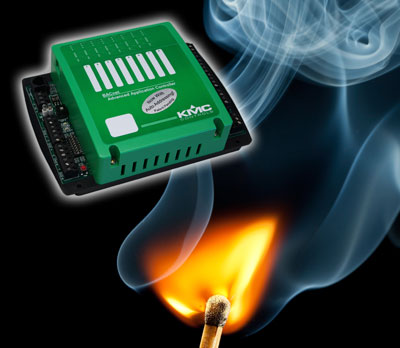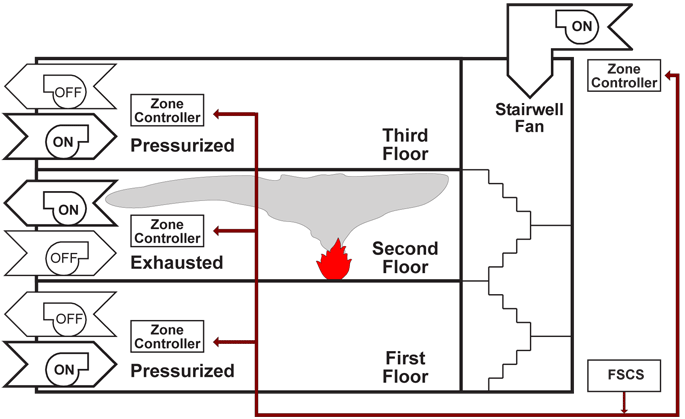Smoke Control and Building Automation Systems

What is Smoke Control?
A smoke control system is a combination of fans, dampers, warning devices, and other equipment that work together to perform the containment function for any smoke event at any location in a building. A properly designed smoke control system should inhibit or prevent the movement of smoke into areas leading to exits or other designated safe zones in a building.
Manipulating smoke is accomplished by using fans and dampers to control air pressure. Smoke consists of gas and small particles light enough to float in air. These properties allow smoke to be moved by guiding the air in and around a smoke-filled area. Based on smoke detection, a zone containing burning material can be automatically exhausted, using fans, to maintain a negative pressure. The intent is to keep the smoke from migrating to a lower pressure area within the building. This is not always an easy task since the fire is producing heat that can cause pressures many times higher than normal building pressures, but a building fire suppression system can reduce the heat produced by the fire and make smoke management systems far more effective (in addition to reducing the destruction caused by the fire itself).
To further help contain the smoke, zones adjacent to the fire zone can be pressurized. In this case, 100% outdoor air is supplied continuously to the areas adjacent to the fire zone while exhaust fans are disabled. In the sample building diagram shown below, a fire is on the second floor, and air is exhausted from that floor. Meanwhile, the floors above and below it, as well as the stairwell, are pressurized. Smoke is thus drawn out of the building through the second floor’s exhaust fan and hindered from entering any other area.

A smoke control system may not be necessary in every building, and it is not a substitute for early smoke detection, well-marked exits, an evacuation plan, and a fire suppression system. These items should be considered the primary means of saving lives and reducing property damage. A smoke control system can aid in the battle to save lives in the event of a fire by providing and maintaining a viable path for exiting the area to safety as well as reducing property damage caused by smoke.
Control devices used in smoke control systems have a UUKL listing. Underwriters Laboratories’ UUKL listing is a category code under UL 864, Control Units and Accessories for Fire Alarm Systems. UUKL is for products covered under the description “Smoke Control System Equipment.” Equipment that receives Underwriters Laboratories UUKL rating has been tested for integrity and long-term reliability. The equipment is subjected to extremes in temperature, humidity, and electrical transients and surges. This testing ensures that the devices will continuously perform even under severe and abnormal conditions. KMC Controls has a variety of products with UUKL ratings.
Dedicated smoke control equipment is used for smoke manipulation only. This equipment only runs if there is a fire or a command from the FSCS. Since it is not used on a daily basis, this equipment requires a weekly self-test to assure it is still in working order.
Non-dedicated smoke control equipment includes air-handling units, exhaust fans, and dampers controlled by a BAS (Building Automation System) that is used for day-to-day control of space conditions for human comfort (temperature and humidity). If a failure occurs on non-dedicated equipment, the fault is more likely to get reported because occupants will complain about the space conditions. Also, a BAS can generate diagnostic alerts to indicate malfunctions in smoke control equipment operation. But unless the equipment is running, little valid diagnostic information can be obtained. For this reason, non-dedicated smoke control equipment is more reliable than dedicated equipment. KMC products are designed for non-dedicated smoke control systems.
Smoke Control Devices
The command for a certain smoke alarm action may come from a Fire Alarm Control Panel (FACP), which is a device for automatically receiving and announcing the location of a fire, based upon input from smoke/flame/heat detectors and manual pull stations. The FACP also sends a signal to the Firefighter’s Smoke Control Station to initiate programmed smoke control procedures. Smoke control mode may be activated automatically, but it must also allow for a manual override option from the Firefighter’s Smoke Control Station.
A
Firefighter’s Smoke Control Station (FSCS) is the manual control center for all smoke control equipment in a building. It is usually installed at a main entrance or other easily accessible location. The panel front usually contains a diagram of the building with locations shown of significant smoke control equipment such as air handlers and dampers. Switches allow the operator to modify the state of the equipment at each floor or zone. Lamps (LEDs) on the panel face display the status of the equipment. (See photo below.) Any command that fails to execute results in an audible and visual alarm.
At the heart of the FSCS are BAS controllers (such as UUKL-listed KMC BAC-5831, BAC-5801/5801, or KMD-5801/5802 controllers). An FSCS may contain multiple controllers. The controllers are used to communicate to the control units in the field and read switch commands and display equipment status at the FSCS.
The controls on an FSCS are left in automatic mode except for testing and actual smoke incidents. As the name indicates, the manual operator is usually a firefighter who understands smoke control and can operate the panel in an effort to prevent loss of life and limit property damage. Manual commands at the FSCS are given the highest priority of any signal in a smoke control system.
Other vital devices related to smoke control are the sensors that detect smoke in the first place and the dampers that help control the ventilation. KMC sells CAE-1003/1103 smoke detectors and the accessory IEE-1000 series of switch and indicator plates. Also, for pneumatic systems, KMC sells the MCP-8035 series smoke damper actuators. These devices are covered under listings other than UL 864 (see their respective data sheets for more information).
Additional Resources
Practical Applications of Smoke-Control Systems in HPAC Engineering
NFPA 92A: Standard for Smoke-Control Systems Utilizing Barriers and Pressure Differences
UL 864 Standard for Control Units and Accessories for Fire Alarm Systems
(Smoke Control Manuals for BACnet and KMDigital systems are available when logged into the KMC Partner’s site)
Feedback